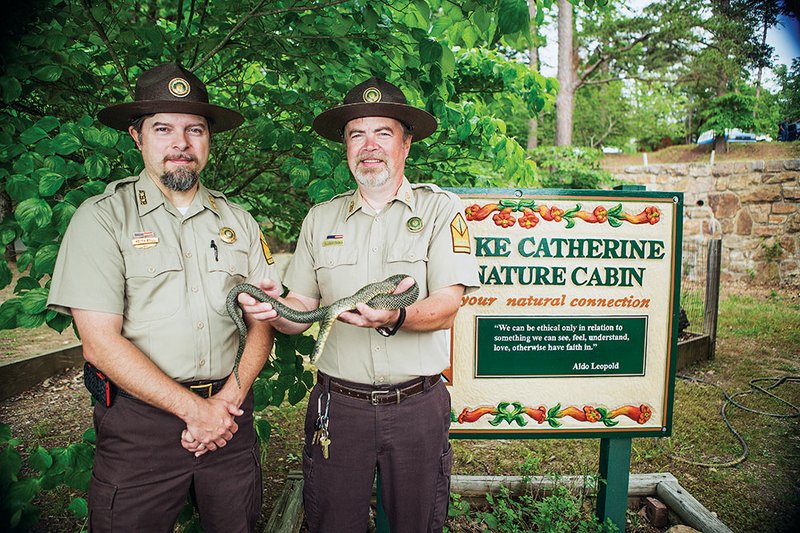LAKE CATHERINE — What other name could you give a celebrity kingsnake but Elvis?
“The name predates me,” said Keith Bell, a park interpreter and Elvis’ chief handler. “I’ve been here just over a year, and he was already named before I arrived.”
Bell and fellow park interpreter Steve Donahou, who conduct programs for visitors at Lake Catherine State Park on Arkansas 171 between Malvern and Hot Springs, said they try not to name any of the other stars — 11 snakes, four turtles, two terrapins, an always changing number of sunfish and one wolf spider — that are kept in the park’s Nature Cabin.
“It’s too anthropomorphic,” Bell said.
The men say giving an animal a human name blurs its character, hides its unique place in nature and doesn’t give it the respect it deserves.
But Elvis is an exception because of his existing fame.
“Everyone wants to meet Elvis,” Donahou said. “We know that featuring a program on snakes will draw a good crowd.”
He said people have a love-hate relationship with snakes — part fascination, part fear.
“They are very controversial,” Donahou said. “We learn from our first stories as children that snakes are bad and that they slither on the ground as punishment for their evil. But people still want to see them up-close.”
Elvis, whose real name is lampropeltis getula holbrooki, or speckled kingsnake, is the star of all the snake-related programs and educational demonstrations regularly scheduled during the summer at the state park.
“He is the main snake and star of the programs Myth and Lore of Snakes, Snakes of Arkansas, the Snake ID demonstration and, of course, our Meet Elvis program,” Bell said. “Elvis is there for all the people who want to hold a snake.”
Donahou said that with as many as three snake programs a week, more than 2,500 people may get a chance to hold Elvis in the summer between Memorial Day and the Labor Day weekend.
The interpreters try to give visitors an understanding of the creatures living in the park.
“I was taught that interpretation is oral communication that goes beyond facts to reveal what things are, how they fit together and why it matters,” Donahou said.
Elvis is more than 2 feet long and perhaps a little more than 1-inch wide. Like most kingsnakes, he is generally black. A yellow spot in the center of most of the scales causes him to look speckled. The belly is yellowish with some black markings forming something like a zipper pattern.
Being cold-blooded, Elvis feels cool in the hands of someone handling him. The park interpreters say he will get livelier as he warms up in the hands holding him.
“He has round black eyes,” said Bell, explaining that nonvenomous snakes have round pupils, while venomous snakes like rattlesnakes or copperheads have elliptical pupils like cats’ eyes.
“Being able to have visitors hold him makes Elvis an important part of our Snake ID program,” Bell said.
“We have a box we can put them in so people can come closer to see a venomous snake,” Donahou said. “Then people can handle Elvis and other nonvenomous snakes.”
Venomous snakes are kept for display at the Nature Cabin. The park also has two copperheads, along with a timber rattlesnake and pygmy rattlesnake. Bell said water moccasins are too lively and aggressive to keep at the park.
Bell said having snakes of both kinds is important to the educational program.
“Many people want to kill every snake they see,” he said. “We want to tell people that most of them are harmless.”
Donahou said Arkansas has 36 species of snakes and only six are poisonous.
“We also heard from people who say snakes like Elvis are good snakes and the other snakes are bad,” Bell said. “Really, all snakes have their place in the world. The only difference is how they hunt their food.”
The park interpreters said the presence of Elvis and other kingsnakes is the best way to keep venomous snakes away.
“They are afraid of even the smell of a kingsnake,” Bell said. “We have a box next to their glass cages where we put them when we clean their cages. We have to put in Elvis last because rattlesnakes or the copperheads won’t go into the box after the kingsnake has been in there.”
Recently, Bell caught another nonvenomous snake at the park that may become part of the education program.
“I found this eastern hognose snake about two weeks ago,” he said. “I learned they are good at playing dead. They can even cause some blood vessels to burst in their mouth to help them appear to be dead.”
The snake has a blunt, upturned nose, earning its name. It is sometimes called a puff adder or a spread adder.
But the star of the programs and demonstrations remains Elvis.
“He is the calmest snake,” Bell said. “He remains docile as he is touched and handed off from one person to the next.”
Long live the King.
For more information about Lake Catherine State Park, visit www.arkansasstateparks.com/lakecatherine.
Staff writer Wayne Bryan can be reached at (501) 244-4460 or wbryan@arkansasonline.com.
